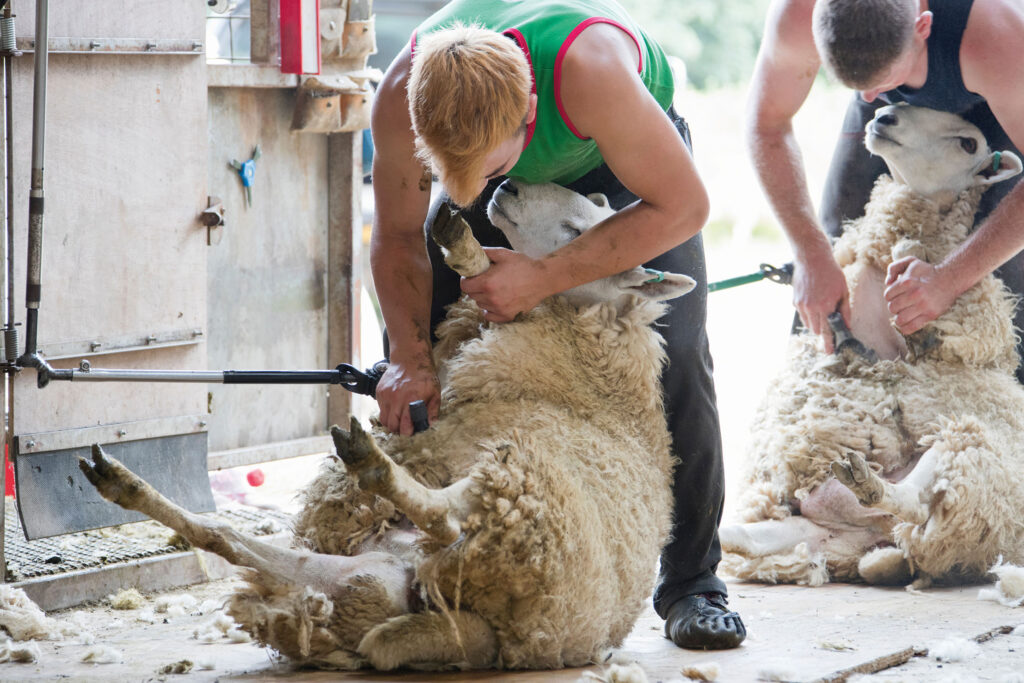
New guidelines aim to reduce disease risks to sheep at shearing as the sector strives to maintain flock health this season.

As shearing gets into full swing, the National Sheep Association (NSA) and other industry bodies are reminding farmers that good biosecurity hinges on effective communication between different parties.
“There is a joint responsibility between farmers and shearers” says Nerys Wright, independent sheep consultant and technical adviser to the Sustainable Control of Parasites in Sheep (SCOPS) group.
Disinfection plan
“If your shearer doesn’t know that your flock has been affected by a contagious disease, such as scab, they may unknowingly spread it”.
The first step is to be honest with your shearer and tell them if you have scab or something else contagious, adds Ms Wright. “They might decide to shear your farm last or agree a disinfection plan before they leave”.
Other sheep, shearing equipment, clothing, shearing trailers, and shearers themselves can all present a disease risk unless steps are taken by farmers and shearing contractors to reduce risks and ensure cleanliness.
Farmers are also reminded that applying pour-on products too close to shearing can reduce their effectiveness and absorption and pose health risks to shearers and wool handlers.
Handling procedure
Recommendations should be followed to ensure safe and responsible handling and application relating to treatments on the wool to avoid unnecessary waste and potential adverse reactions.
NSA chief executive Phil Stocker said: “It is vital that all involved in shearing ensure they are working at the highest possible standard and following best practice guidelines to ensure optimum health and welfare of both sheep and handlers is maintained.”
Detailed guidance on how farmers and shearers can share responsibility for animal welfare and avoid disease spread can be found in the Industry Guidance on Shearing, which has been recently updated to reflect an increased focus on animal health.
By following these guidelines, farmers and shearing contractors can cooperate to significantly reduce the risk of disease spread and ensure a healthier flock during shearing season.
Guidelines for sheep health at shearing
Health status – Agree on what steps will be taken to safeguard health status and prevent disease spread. Foot rot, particularly contagious ovine digital dermatitis, scab, lice, ticks and caseous lymphadenitis should be discussed.
Disinfect – Shearers should clean and disinfect combs and cutters, shearing trailers, and change clothes (including moccasins) after finishing with each flock. Remember to assist shearers by helping with any cleaning and disinfecting procedures where you can
Reduce exposure – Shear younger, fitter sheep first, followed by older and less healthy sheep to reduce the risk of cross-infection.
Personal hygiene – Everyone handling sheep should wash hands frequently and clean and disinfect boots.
Clean and disinfect – Sheep with obvious issues that could infect the handpiece, such as orf, scab, or lumps should prompt the shearer to stop, change/disinfect combs and cutters and other items. Wash hands where necessary.
Royal award for industry leader

Dairy industry leader Judith Bryans has received a royal award in recognition of her outstanding lifetime contribution to the dairy industry.
Dr Bryans, who is chief executive of Dairy UK, was presented with the Royal Association of British Dairy Farmers Princess Royal Award during a special ceremony at Gatcombe Park, celebrating excellence and leadership within the sector.
The award is presented annually to an individual who has made a significant and lasting impact on the dairy industry. Selected by the RABDF board of trustees, Dr Bryans was chosen unanimously as this year’s winner.
Dr Bryans began her career as director of the Dairy Council before taking the helm at Dairy UK in 2013. She has driven the Dairy Roadmap, which outlines the sector’s sustainability goals and commitments.
Life’s work
Dr Bryans said: “The dairy industry continues to be my life’s work. I am incredibly proud of the progress we have made in strengthening the sector, improving sustainability, and ensuring a bright future for the next generation of dairy farmers.”
RABDF chairman Robert Craig said: “Dr Bryans’ contribution to the dairy sector is truly remarkable. Her leadership and vision have not only shaped the future of the UK dairy industry but have also had a far-reaching impact on the global stage.”
Demand for action on food security
News Oct 3, 2025
Kemi Badenoch hits out on inheritance tax
News Aug 27, 2025
Police crush vehicle used in farm burglary
News Aug 27, 2025
Industry pays tribute to David Richardson
News Aug 27, 2025
Defra must learn from drought, say industry leaders
News Aug 27, 2025








